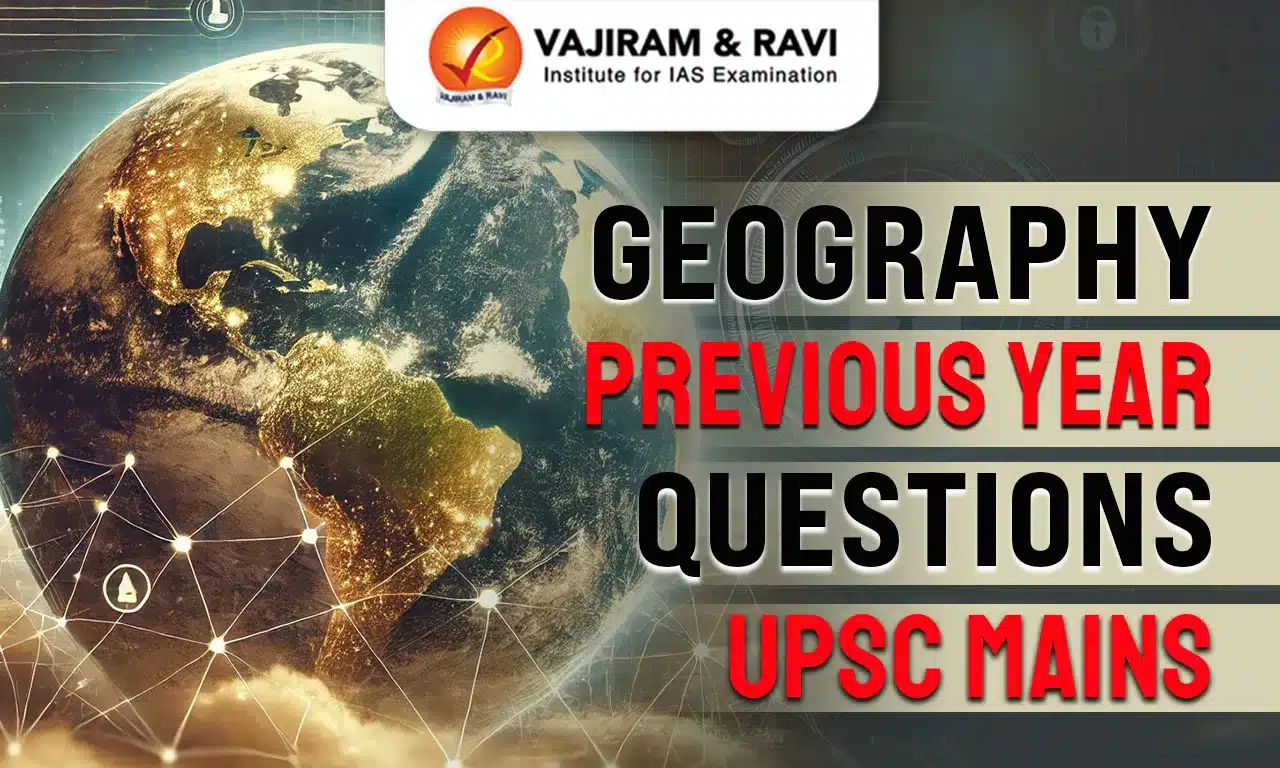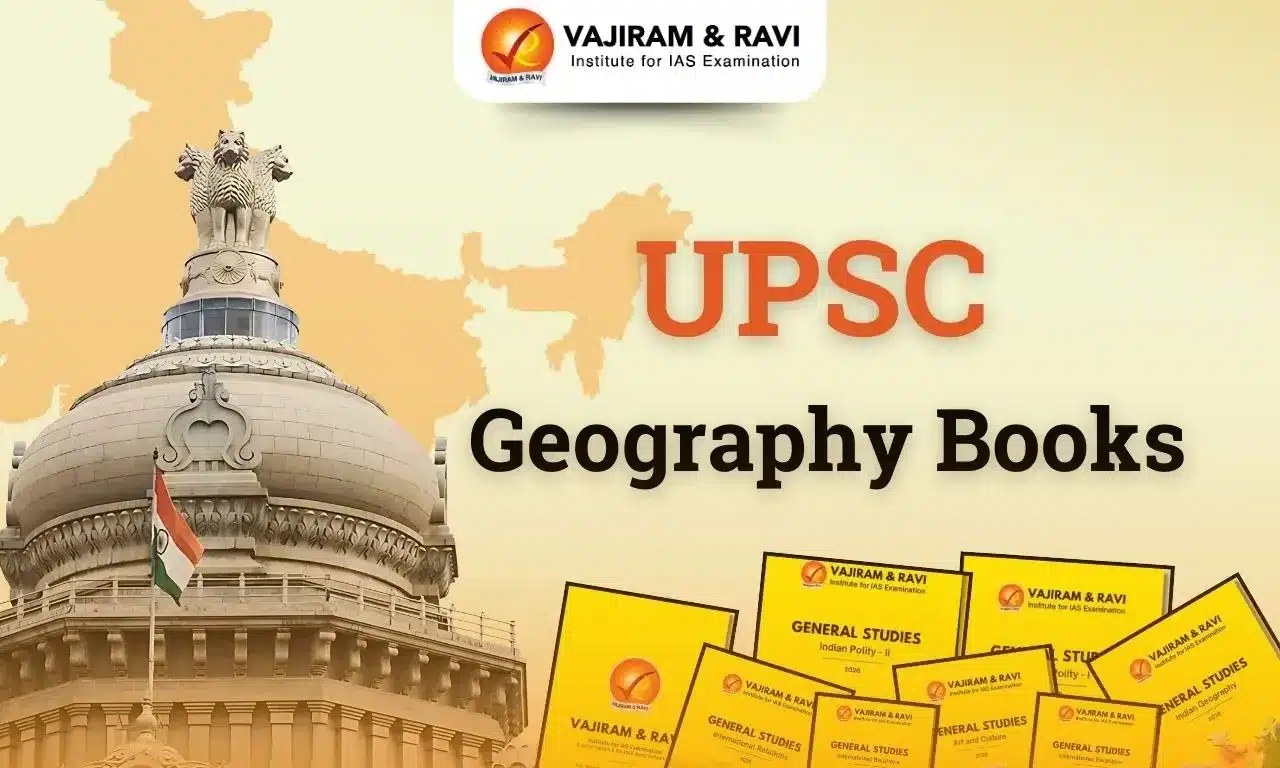The Geography Previous Year Questions for UPSC Mains in the Civil Services Examination are a part of the General Studies Paper 1 syllabus. The major topics covered in these questions are physical geography, climate and resource distribution, urbanization, and factors responsible for the location of industries.
This article has divided the Geography Mains Previous Year Questions topic-wise and year-wise. This is helpful for candidates to analyze the paper pattern and understand the important topics. It is important to study the Geography Mains PYQs thoroughly and revise the topics intellectually to score well in the exam.
Geography Questions in UPSC Mains 2024
- What is sea surface temperature rise? How does it affect the formation of tropical cyclones?
- What is the phenomenon of ‘cloudbursts’? Explain.
- What is the concept of a ‘demographic winter’? Is the world moving towards such a situation? Elaborate.
- The groundwater potential of the gangetic valley is on a serious decline. How may it affect the food security of India?
- What are aurora australia and aurora borealis? How are these triggered?
- What is a twister? Why are the majority of twisters observed in areas around the Gulf of Mexico?
Geography Questions in UPSC Mains 2023
- Discuss the consequences of climate change on the food security in tropical countries.
- Why is the world today confronted with a crisis of availability of and access to freshwater resources?
- How are the fjords formed? Why do they constitute some of the most picturesque areas of the world?
- Why is the South-West Monsoon called Purvaiys’ (easterly) in Bhojpur Region? How has this directional seasonal wind system influenced the cultural ethos of the region?
- Comment on the resource potentials of the long coastline of India and highlight the status of natural hazard preparedness in these areas.
- Identify and discuss the factors responsible for diversity of natural vegetation in India. Assess the significance of wildlife sanctuaries in rain forest regions of India.
- Why did human development fail to keep pace with economic development in India?
- From being a net food importer in the 1960s, India has emerged as a net food exporter to the world. Provide reasons.
Geography UPSC Mains Previous Year Questions 2022
- Discuss the meaning of colour-coded weather warnings for cyclone-prone areas given by the India Meteorological Department.
- Discuss the natural resource potential of the ‘Deccan trap’.
- Describe the characteristics and type of primary rocks.
- The troposphere is a very significant atmosphere layer that determines weather processes. How?
- Mention the significance of straits and isthmus in international trade.
- Examine the potential of wind energy in India and explain the reasons for its limited spatial spread.
- What are the forces that influence ocean currents? Describe their role in the fishing industry of the world.
- Describing the distribution of rubber-producing countries indicates their major environmental issues.
Geography UPSC Mains Previous Year Questions 2021
- Differentiate the causes of landslides in the Himalayan region and the Western Ghats.
- Despite India being one of the countries of the Gondwanaland, its mining industry contributes much less to its Gross Domestic Product (GDP) in percentage. Discuss.
- What are the environmental implications of recreating the water bodies into urban land use? Explain with examples.
- Mention the global occurrence of volcanic eruptions in 2021 and their impact on the regional environment.
- Why is India considered a subcontinent? Elaborate on your answer.
- Briefly mention the alignment of major mountain ranges of the world and explain their impact on local weather conditions, with examples.
- How does the melting of the Arctic ice and glaciers of the Antarctic differently affect the weather patterns and human activities on the Earth? Explain.
- Discuss the multi-dimensional implications of the uneven distribution of mineral oil in the world.
Geography UPSC Mains Previous Year Questions 2020
- Discuss the geophysical characteristics of the Circum-Pacific Zone.
- The interlinking of rivers can provide viable solutions to the multi-dimensional inter-related problems of droughts, floods, and interrupting navigation. Critically examine.
- The process of desertification does not have climate boundaries. Justify with examples.
- How will the melting of Himalayan glaciers have a far-reaching impact on the water resources of India?
- India has immense potential for solar energy though there are regional variations in its developments. Elaborate.
- Examine the status of forest resources in India and its resultant impact on climate change.
- Account for the huge flooding of a million cities in India including the smart ones like Hyderabad and Pune. Suggest lasting remedial measures.
Geography UPSC Mains Previous Year Questions 2019
- How can the mountain ecosystem be restored from the negative impact of development initiatives and tourism?
- Discuss the factors for localisation of agro-based food processing industries of North-West India.
- Can the strategy of regional resource-based manufacturing help in promoting employment in India?
- Assess the impact of global warming on the coral life system with examples
- How ocean currents and water masses differ in their impacts on marine life and the coastal environment? Give suitable examples.
- Discuss the causes of the depletion of mangroves and explain their importance in maintaining coastal ecology.
- What is water stress? How and why does it differ regionally in India?
Geography UPSC Mains Previous Year Questions 2018
- Define mantle plume and explain its role in plate tectonics.
- “The ideal solution of depleting groundwater resources in India is water harvesting system.” How can it be made effective in urban areas?
- Defining blue revolution, explain the problems and strategies for pisciculture development in India.
- Why is India taking keen interest in the Arctic region?
- What is the significance of Industrial Corridors in India? Identifying industrial corridors, explain their main characteristics.
- Why is Indian Regional Navigational Satellite System (IRNSS) needed? How does it help in navigation?
Geography UPSC Mains Previous Year Questions 2017
- Account for variations in oceanic salinity and discuss its multi-dimensional effects.
- Mention the advantages of the cultivation of pulses because of which the year 2016 was declared as the International Year of Pulses by the United Nations.
- Petroleum refineries are not necessarily located nearer to crude oil-producing areas, particularly in many of the developing countries. Explain its implications.
- In what way can floods be converted into a sustainable source of irrigation and all weather inland navigation in India?
- How does the Cryosphere affect climate change?
- "In spite of adverse environmental impact, coal mining is still inevitable for development." Discuss.
- What characteristics can be assigned to monsoon climate that succeeds in feeding more than 50 per cent of the world population residing in Monsoon Asia?
Last updated on December, 2025
→ Check out the latest UPSC Syllabus 2026 here.
→ Join Vajiram & Ravi’s Interview Guidance Programme for expert help to crack your final UPSC stage.
→ UPSC Mains Result 2025 is now out.
→ UPSC Notification 2026 is scheduled to be released on January 14, 2026.
→ UPSC Calendar 2026 is released on 15th May, 2025.
→ The UPSC Vacancy 2025 were released 1129, out of which 979 were for UPSC CSE and remaining 150 are for UPSC IFoS.
→ UPSC Prelims 2026 will be conducted on 24th May, 2026 & UPSC Mains 2026 will be conducted on 21st August 2026.
→ The UPSC Selection Process is of 3 stages-Prelims, Mains and Interview.
→ UPSC Result 2024 is released with latest UPSC Marksheet 2024. Check Now!
→ UPSC Prelims Result 2025 is out now for the CSE held on 25 May 2025.
→ UPSC Toppers List 2024 is released now. Shakti Dubey is UPSC AIR 1 2024 Topper.
→ UPSC Prelims Question Paper 2025 and Unofficial Prelims Answer Key 2025 are available now.
→ UPSC Mains Question Paper 2025 is out for Essay, GS 1, 2, 3 & GS 4.
→ UPSC Mains Indian Language Question Paper 2025 is now out.
→ UPSC Mains Optional Question Paper 2025 is now out.
→ Also check Best IAS Coaching in Delhi
Geography Previous Year Questions for UPSC Mains FAQs
Q1. Where can I find Geography Mains Questions?+
Q2. How to Prepare Geography for UPSC?+
Q3. How to Prepare Geography Mains Questions for UPSC 2025?+
Q4. How many Geography Mains Previous Year Questions were asked in the UPSC Exam over the years?+

















